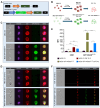Oncogenic KRASG12D Transfer from Platelet-like Particles Enhances Proliferation and Survival in Non-Small Cell Lung Cancer Cells
- PMID: 40244100
- PMCID: PMC11990068
- DOI: 10.3390/ijms26073264
Oncogenic KRASG12D Transfer from Platelet-like Particles Enhances Proliferation and Survival in Non-Small Cell Lung Cancer Cells
Abstract
In the tumor context, platelets play a significant role in primary tumor progression, dissemination and metastasis. Analysis of this interaction in various cancers, such as non-small cell lung cancer (NSCLC), demonstrate that platelets can both transfer and receive biomolecules (e.g. RNA and proteins) to and from the tumor at different stages, becoming tumor-educated platelets. To investigate how platelets are able to transfer oncogenic material, we developed in vitro platelet-like particles (PLPs), from a differentiated MEG-01 cell line, that stably carry RNA and protein of the KRASG12D oncogene in fusion with GFP. We co-cultured these PLPs with NSCLC H1975 tumor cells to assess their ability to transfer this material. We observed that the generated platelets were capable of stably expressing the oncogene and transferring both its RNA and protein forms to tumor cells using qPCR and imaging techniques. Additionally, we found that coculturing PLPs loaded with GFP-KRASG12D with tumor cells increased their proliferative capacity at specific PLP concentrations. In conclusion, our study successfully engineered an MEG-01 cell line to produce PLPs carrying oncogenic GFP-KRASG12D simulating the tumor microenvironment, demonstrating the efficient transfer of this oncogene to tumor cells and its significant impact on enhancing proliferation.
Keywords: KRAS; non-small cell lung cancer; oncogene transfer; platelet-like-particles.
Conflict of interest statement
The authors declare no conflicts of interest.
Figures




References
-
- Best M.G., Sol N., Kooi I., Tannous J., Westerman B.A., Rustenburg F., Schellen P., Verschueren H., Post E., Koster J., et al. RNA-Seq of Tumor-Educated Platelets Enables Blood-Based Pan-Cancer, Multiclass, and Molecular Pathway Cancer Diagnostics. Cancer Cell. 2015;28:666–676. doi: 10.1016/j.ccell.2015.09.018. - DOI - PMC - PubMed
MeSH terms
Substances
Grants and funding
LinkOut - more resources
Full Text Sources
Medical
Research Materials
Miscellaneous

